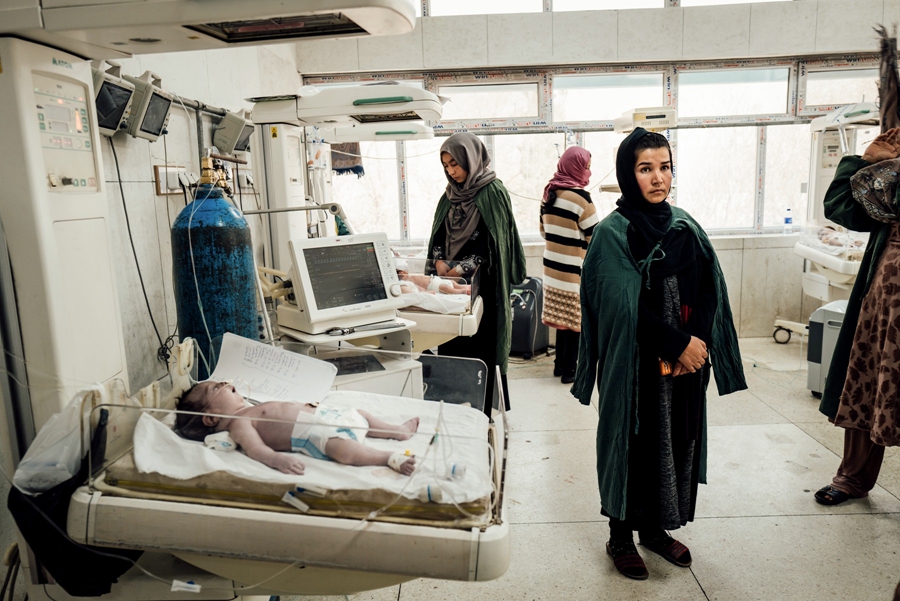Afghanistan: The Cost of Peace
Text and photos by Adrien Vautier/Le Pictorium
Abridged by Syharn Shen (沈思含)
Afghanistan: The Cost of Peace
Text and photos by Adrien Vautier/Le Pictorium
Abridged by Syharn Shen (沈思含)

In a hotel in Mazar, a family from Kabul wait for evacuation to the U.S. The Taliban have come to their home several times to look for the father, a former regime executive. They had to flee in the middle of the night, each with a bag of belongings.
Three and a half months after the capture of Kabul, Afghanistan's new masters are struggling to govern the country. With a health, financial and economic crisis, but also a crisis of confidence, the Emirate is already close to collapse. Women and children are the first to pay the price.
The American occupation and its daily violence was a tragedy for the Afghanistans, but the return of the Taliban to power on August 15, 2021 and the precipitous departure of the Westerners at the end of August wiped out twenty years of progress and hard-won rights by and for women. In the meantime, the number of students who attend classes has decreased. Secondary schools reopened in mid-September of 2021, but only boys were allowed to attend, as the Taliban said they needed time to create an environment suitable for girls' education. With the exception of a very few, millions of young Afghan women are still denied a secondary education.
Despite the risks, feminist activists, some barely of age, dare to challenge the fundamentalists in the streets as their rights are exponetionally reduced. Educated and with mobile phones, the Internet and social networks, Afghan women today have the tools to organize, spread their struggle, and encourage other women to resist. But the repression is strong. Arrests, beatings and tear gas were all employed to stop the protests as the Taliban does not hesitate to use force to silence the female opposition.

On September 11, 2021, the Taliban invited local and international journalists to an event to promote education among women in the Emirate. Dozens of female students wearing Niqab are present in the amphitheatre of the Polytechnic University to support the fundamentalists' policy.
Since the return to power of the Taliban, the country has also plunged into a economic crisis. In Herat, some Afghans are willing to sell a child or a kidney to survive.
For a fortnight, Abdul Wakeel, 50, his wife Golafroz and their three children have been sleeping on a grey tarpaulin in the Bagh-e-Mellat neighborhood in Herat, along with hundreds of other families. In Ghor, their home province, they sold everything, starting with dishes and carpets, to get some cash to buy food. When there was nothing left to sell, there was an exodus in desperation to find support in Herat, the third largest city in Afghanistan.
We spoke with Abdul, one of these many desperate fathers, who had sold everything to reach Herat in search for a job. Hesitant and with the face of a man with no more dignity left, he said: "Do you want to buy my five-year-old daughter? She is the last remaining in the family and I do not know what else I can do to feed her."
A few months ago, these fathers would have never come to this. But the crisis has plunged some families into immense distress. "Once we have sold our daughters and all our belongings, we will see what God has in store for us. And after that, there will be nothing left but death," he continues.

Taliban patrols in the city of Mazar-e Sharif. A significant number of young men have joined the Taliban army in recent years. In a country wracked by war, some believe that only the fundamentalists can bring peace and prosperity.
As one of the most dangerous places for a child to be, Afghanistan has seen more than 552 children killed and over 1,400 injured since the beginning of 2021. Almost 550,000 people, more than half of them children, have been displaced in 2021. An estimate showed that by the end of 2021, nearly two million children need humanitarian assistance, more than a million children under five are severely malnourished, and three million suffer from malnutrition. Afghanistan is also on the brink of a massive famine that threatens to kill over a million children. It is a race against time, and every day without treatment or aid threatens the lives of thousands of children.
With escalating violence, the Covid-19 pandemic, a down economy, and a drought crisis, foreign aid is not enough and was frozen following the Taliban takeover. "The international community should care about Afghans, not politics. A dying mother has nothing to do with the Taliban," argues Mohammad Asef Kabir, deputy of the Herat Public Health Department. "If the rest of the world does not want Afghanistan to suffer a huge humanitarian crisis, international funding must resume," he implores.

This is the premature birth ward of the Indira Ghandi Children's Hospital in Kabul. Since the capital city has been captured by the Taliban, the lives of Afghanistans, especially women and children, have been severely impacted.
Contact Us | Plan a Visit | Donate
8 Lide Road, Beitou 11259, Taipei, Taiwan
886-2-2898-9999
005741@daaitv.com
©Tzu Chi Culture and Communication Foundation
All rights reserved.
